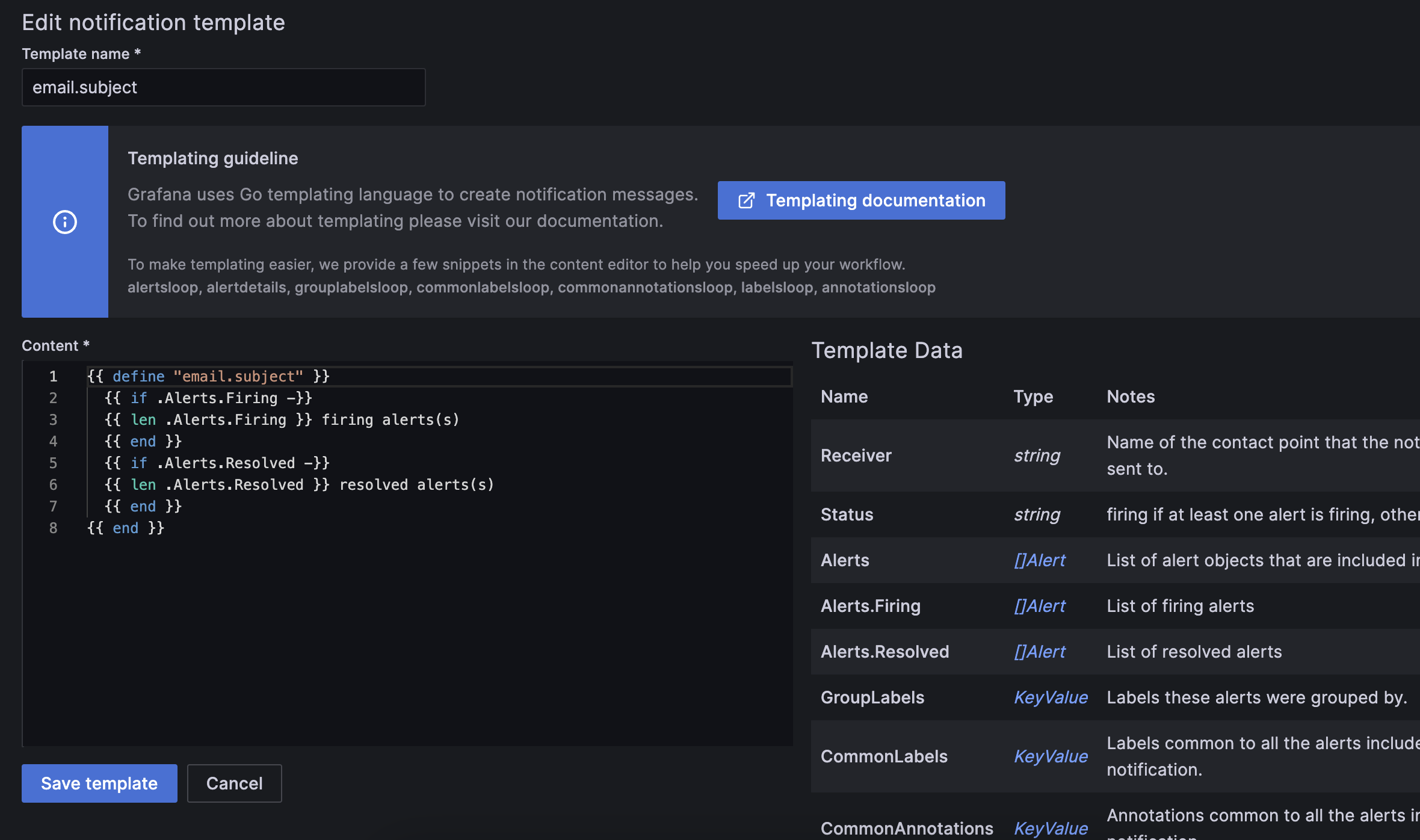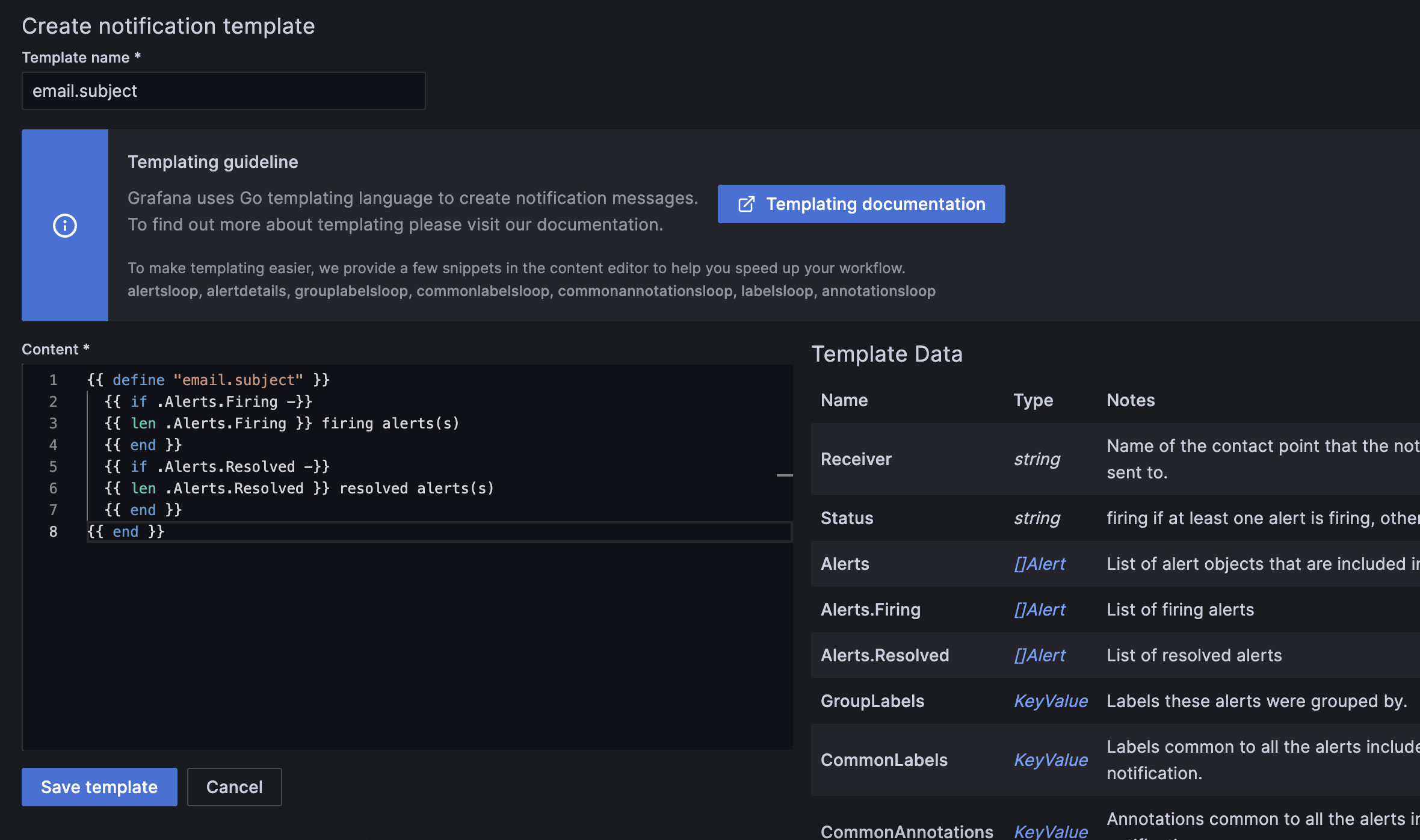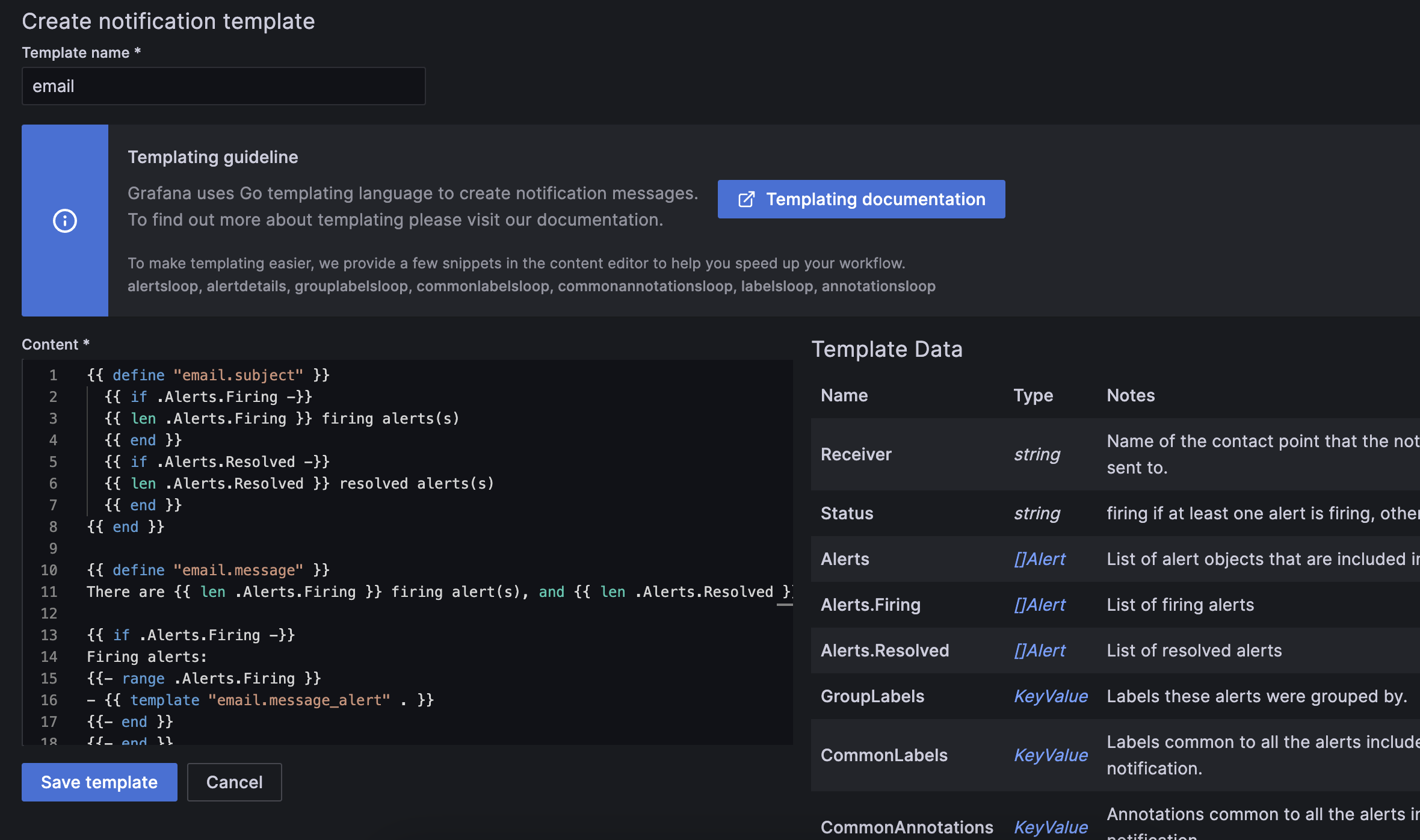Important: This documentation is about an older version. It's relevant only to the release noted, many of the features and functions have been updated or replaced. Please view the current version.
Create notification templates
Create reusable notification templates to send to your contact points.
You can add one or more templates to your notification template.
Your notification template name must be unique. You cannot have two templates with the same name in the same notification template or in different notification templates. Avoid defining templates with the same name as default templates, such as: __subject, __text_values_list, __text_alert_list, default.title and default.message.
In the Contact points tab, you can see a list of your notification templates.
To create a template, complete the following steps.
Click Add template.
Choose a name for the notification template.
Write the content of the template in the content field.
![New notification template email.subject New notification template email.subject]()
New notification template email.subject Click Save.
{{ define "email.subject" }} and {{ end }} is automatically added to the start and end of the content:

To create a notification template that contains more than one template:
Click Add Template.
Enter a name for the notification template.
Write each template in the Content field, including
{{ define "name-of-template" }}and{{ end }}at the start and end of each template.![New notification template New notification template]()
New notification template Click Save.
Template the subject of an email
Template the subject of an email to contain the number of firing and resolved alerts:
1 firing alert(s), 0 resolved alerts(s)Create a template called
email.subjectwith the following content:{{ define "email.subject" }} {{ len .Alerts.Firing }} firing alert(s), {{ len .Alerts.Resolved }} resolved alert(s) {{ end }}Execute the template from the subject field in your contact point integration:
{{ template "email.subject" . }}
Template the message of an email
Template the message of an email to contain a summary of all firing and resolved alerts:
There are 2 firing alert(s), and 1 resolved alert(s)
Firing alerts:
- alertname=Test 1 grafana_folder=GrafanaCloud has value(s) B=1
- alertname=Test 2 grafana_folder=GrafanaCloud has value(s) B=2
Resolved alerts:
- alertname=Test 3 grafana_folder=GrafanaCloud has value(s) B=0Create a notification template called
emailwith two templates in the content:email.message_alertandemail.message.The
email.message_alerttemplate is used to print the labels and values for each firing and resolved alert while theemail.messagetemplate contains the structure of the email.{{- define "email.message_alert" -}} {{- range .Labels.SortedPairs }}{{ .Name }}={{ .Value }} {{ end }} has value(s) {{- range $k, $v := .Values }} {{ $k }}={{ $v }}{{ end }} {{- end -}} {{ define "email.message" }} There are {{ len .Alerts.Firing }} firing alert(s), and {{ len .Alerts.Resolved }} resolved alert(s) {{ if .Alerts.Firing -}} Firing alerts: {{- range .Alerts.Firing }} - {{ template "email.message_alert" . }} {{- end }} {{- end }} {{ if .Alerts.Resolved -}} Resolved alerts: {{- range .Alerts.Resolved }} - {{ template "email.message_alert" . }} {{- end }} {{- end }} {{ end }}Execute the template from the message field in your contact point integration:
{{ template "email.message" . }}
Template the title of a Slack message
Template the title of a Slack message to contain the number of firing and resolved alerts:
1 firing alert(s), 0 resolved alerts(s)Create a template called
slack.titlewith the following content:{{ define "slack.title" }} {{ len .Alerts.Firing }} firing alert(s), {{ len .Alerts.Resolved }} resolved alert(s) {{ end }}Execute the template from the title field in your contact point integration:
{{ template "slack.title" . }}
Template the content of a Slack message
Template the content of a Slack message to contain a description of all firing and resolved alerts, including their labels, annotations, Silence URL and Dashboard URL:
1 firing alert(s):
[firing] Test1
Labels:
- alertname: Test1
- grafana_folder: GrafanaCloud
Annotations:
- description: This is a test alert
Silence: https://example.com/alerting/silence/new?alertmanager=grafana&matcher=alertname%3DTest1&matcher=grafana_folder%3DGrafanaCloud
Go to dashboard: https://example.com/d/dlhdLqF4z?orgId=1
1 resolved alert(s):
[firing] Test2
Labels:
- alertname: Test2
- grafana_folder: GrafanaCloud
Annotations:
- description: This is another test alert
Silence: https://example.com/alerting/silence/new?alertmanager=grafana&matcher=alertname%3DTest2&matcher=grafana_folder%3DGrafanaCloud
Go to dashboard: https://example.com/d/dlhdLqF4z?orgId=1Create a template called
slackwith two templates in the content:slack.print_alertandslack.message.The
slack.print_alerttemplate is used to print the labels, annotations, SilenceURL and DashboardURL while theslack.messagetemplate contains the structure of the notification.{{ define "slack.print_alert" -}} [{{.Status}}] {{ .Labels.alertname }} Labels: {{ range .Labels.SortedPairs -}} - {{ .Name }}: {{ .Value }} {{ end -}} {{ if .Annotations -}} Annotations: {{ range .Annotations.SortedPairs -}} - {{ .Name }}: {{ .Value }} {{ end -}} {{ end -}} {{ if .SilenceURL -}} Silence: {{ .SilenceURL }} {{ end -}} {{ if .DashboardURL -}} Go to dashboard: {{ .DashboardURL }} {{- end }} {{- end }} {{ define "slack.message" -}} {{ if .Alerts.Firing -}} {{ len .Alerts.Firing }} firing alert(s): {{ range .Alerts.Firing }} {{ template "slack.print_alert" . }} {{ end -}} {{ end }} {{ if .Alerts.Resolved -}} {{ len .Alerts.Resolved }} resolved alert(s): {{ range .Alerts.Resolved }} {{ template "slack.print_alert" .}} {{ end -}} {{ end }} {{- end }}Execute the template from the text body field in your contact point integration:
{{ template "slack.message" . }}
Template both email and Slack with shared templates
Instead of creating separate notification templates for email and Slack, you can share the same template.
For example, if you want to send an email with this subject and Slack message with this title:
1 firing alert(s), 0 resolved alerts(s)Create a template called
common.subject_titlewith the following content:{{ define "common.subject_title" }} {{ len .Alerts.Firing }} firing alert(s), {{ len .Alerts.Resolved }} resolved alert(s) {{ end }}For email, execute the template from the subject field in your email contact point integration:
{{ template "common.subject_title" . }}For Slack, execute the template from the title field in your Slack contact point integration:
{{ template "common.subject_title" . }}





